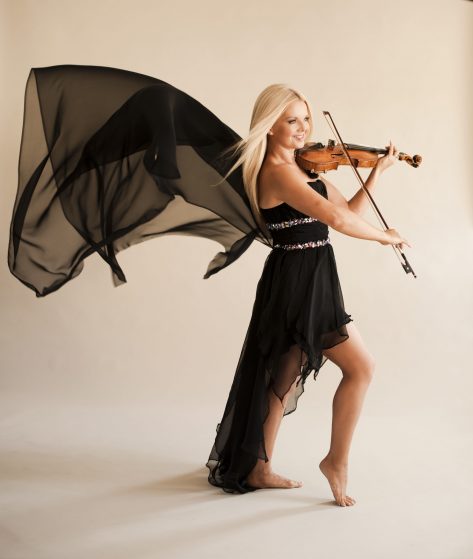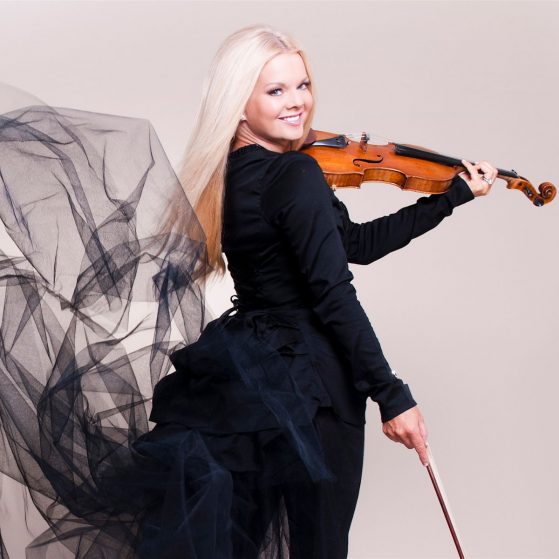
Violinist Máiréad Nesbitt was born in County Tipperary, Ireland and wherever you see her on stage she brings a little of that beauty and magic with her. To hear Máiréad tell the story, she got a late start. “I started with the piano when I was four and then the fiddle/violin at six years of age because my mother and my sister and my father, all my family play music. They’re all amazing musicians, I come from a very musical family, so I’m extremely lucky. The piano was just such a great foundation instrument for classical music and of course the tin whistle then is a great foundation instrument for traditional music. It’s fantastic because it gives you a grasp, not only on your melody, treble hand, but harmonies for the bass hand as well.”
Despite her “late” start Máiréad showed a natural aptitude for the instrument and began performing in public soon after. Her talent was recognized early on, and she was the winner of the All-Ireland Fiddle Championship and a member of the National Youth Orchestra of Ireland. The young Máiréad sought to tackle not only traditional Irish tunes but classical repertoire as well and to create her own unique sound. “At that time, when I was growing up anyway, it was frowned upon.”
Although the violin and fiddle are the same instrument the way they are played separates the two. Of the differences Máiréad told us, “I was going to say the big thing is the bowing, but to be honest, both hands are a huge deal because they really lend themselves to the vibe. For instance, if you’re playing something in 4/4 like a reel, in classical bowing it’s going to sound very square. Whereas if you change your bowing to a traditional Irish bowing, which isn’t a lot of bow trebles, weaving bowing, the figure of eight (classical musicians will know what I’m talking about about the figure of eight) in classical music. There’s a lot of that in Irish traditional music.”
Both styles appealed to Máiréad, “I wanted to embody both styles, but do it properly. I have two separate bow holds for classical music and for Irish music. Also vibrato is a big thing not to use in Irish traditional music, just the tiniest, tiniest bit, very similar to Baroque music. So there’s a lot of similarities with early classical/late Baroque and Irish traditional music. I really gravitated towards that because I love Bach as my favorite composer, and of course, Vivaldi, Handel, Telemann, Geminiani – so many composers that I love from the Baroque era. And so, I really wanted to embrace that in my styles, and I managed to keep them both separate.”
It may have required extra diligence on her part to specialize in multiple styles but for Máiréad it allowed her “the best of all the worlds.” However, it was not only her wide range that drew audiences to Máiréad but the way she moved across the stage, “I loved to move,” she tells us but states strongly that the music has always come first, it was because her technique was already so strong that Máiréad could explore that aspect. “If the music moves me, I would move, if that makes sense and I started doing that.” She credits this exploration to her participation in Michael Flatley’s Lord of the Dance. “It was actually very little movement to what I usually do now but it really kind of helped. They just said, do what you want to do. There is your entrance, there is your exit… do whatever you want to do in between. It was such a fantastic thing to get that freedom on stage and for them to trust me to do that. I was really, really happy about that.”
Máiréad continued working with Michael Flatley on “Feet of Flames.” She was then offered a gig in what was meant to be a one time special with four Irish singers and Irish composer and arranger David Downes for PBS television. The show was, of course, Celtic Woman. The response from fans was overwhelming and Máiréad and her other colleagues found themselves touring around the world.

Máiréad quickly became a fan favorite with her virtuosic playing and captivating stage presence. The group had a grueling schedule which eventually led to all of the original members moving on. Máiréad was the last to leave and was featured on a total of 11 Celtic Woman albums with each going to No.1 on the Billboard World Music Charts. Her final featured album “Destiny” was also nominated for a Grammy Award.
Máiréad has shown different sides of her style with each solo release. Her debut “Raining Up” record is “one of my favorite albums actually because I was going through a real dance phase then.” With “Hibernia” Máiréad shared more of her classical roots, “I wanted to do an orchestral album.” Her next album “Devils Bit Sessions” was a family collaboration which was recorded over the course of a weekend but she says, “took a year to organize it to make sure everyone was there at the same time.” It has a very different feel being a live album and including the natural banter between the players. Máiréad is especially proud of the range of the albums, “I’m really, really happy about that.. it’s just nice, as you said that people just recognize the authenticity there. I think it’s so important and you have to be genuine in what you do. And that’s the family I come from and that’s what we’re all about.”
“Celtic Spells” is a new production that draws on Máiréad’s various professional experiences. “Celtic Spells is about two people falling in love. They’re from different backgrounds. They fall in love, and they have a Handfasting ceremony and they get married. It’s frowned upon and they have to leave their home country to go to the new world… It’s an ancient story, but it’s relevant today as well and just lends itself to telling it in a musical form.”
The live show and accompanying recording will feature a variety of instrumental, vocal and dance talent. “What I wanted to do with this album is to bring together the high production value of the orchestration, but also to have the warmth and the rawness of the live music like a session in Ireland… there’s even some spoken word on there as well.”
In addition to performing and recording, Máiréad also developed her own line of custom violins. The move takes her back to one of her first jobs, “I grew up actually warming up violins and fiddles for a friend of the family called Tommy Robinson, who was a violin dealer.”
Máiréad didn’t have a violin of her own at the time but would have the opportunity to try a variety of instruments working with Tommy. “By playing it a lot every day, the wood becomes very warm, and the sound completely opens up. The violin itself sounds much better to sell so that was my job. As a kid, I loved it, and it really instilled a great love of violins and fiddles in me.”
Her collection features instruments from the beginner to elite end. “I wanted to bring affordable quality to people because I didn’t have an instrument for quite a while myself growing up.”
In conversing with Máiréad, her love for music is palpable. She speaks passionately about the joy and magic that comes from creating and performing music, and her enthusiasm is infectious. Whether performing traditional Irish tunes or blending genres to create something new, Nesbitt’s fiddle playing is always characterized by a sense of magic and wonder. She is a true treasure in the musical world, and a performer who is sure to continue inspiring and delighting audiences for many years to come.
“CELTIC SPELLS, two hearts, a forbidden love, one life, one dream. A journey to a new land, across the sea. This is their story; these are their Celtic Spells.
A new production by Grammy and Emmy nominated artist and one of the founding members of Celtic Woman, Máiréad Nesbitt.








